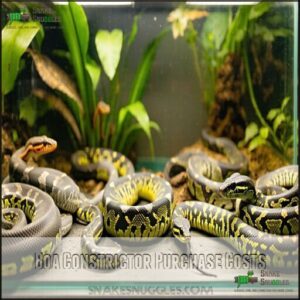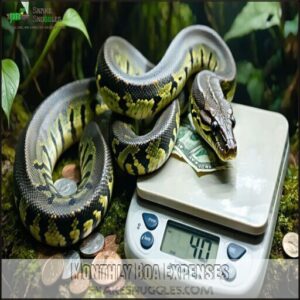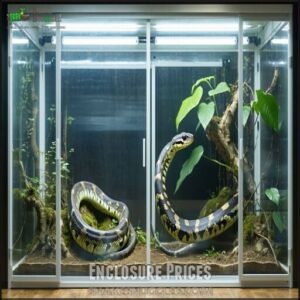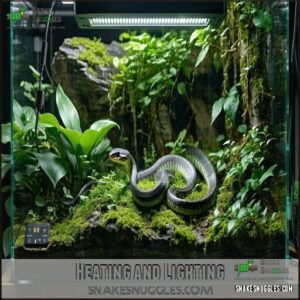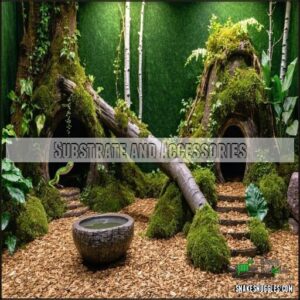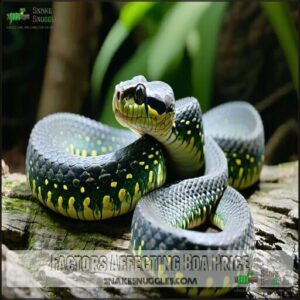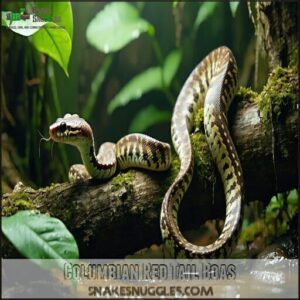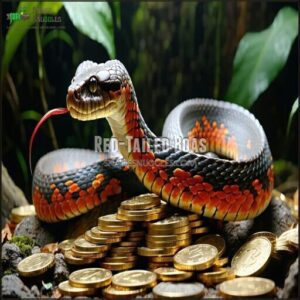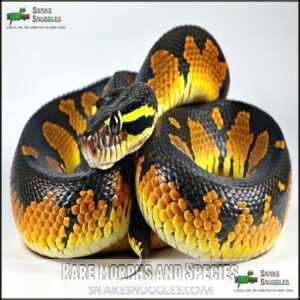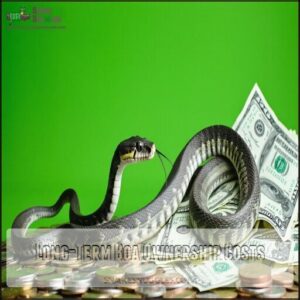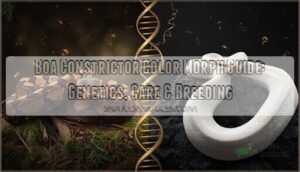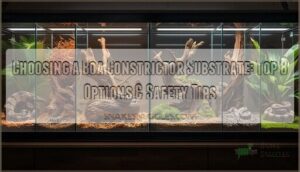This site is supported by our readers. We may earn a commission, at no cost to you, if you purchase through links.
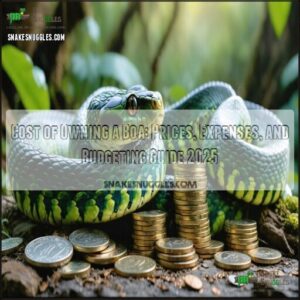
The total cost of owning a boa includes a proper enclosure ($200-500), heating equipment ($100-150), and substrate ($20-30 monthly).
You’ll need to budget for feeding ($15-30 monthly), veterinary care ($100-200 annually), and potential habitat upgrades as your snake grows.
Factor in electricity costs for heating elements and occasional bulb replacements, as understanding the full financial picture helps guarantee you can provide proper care throughout your boa’s long-term commitment.
Table Of Contents
- Key Takeaways
- Boa Constrictor Purchase Costs
- Monthly Boa Expenses
- Health Care Expenses
- Habitat Setup Costs
- Ongoing Care Expenses
- Factors Affecting Boa Price
- Buying a Boa Constrictor
- Boa Constrictor Species Prices
- Long-Term Boa Ownership Costs
- Total Cost of Boa Ownership
- Frequently Asked Questions (FAQs)
- How much do boa constrictors cost?
- How much does a baby boa snake cost?
- Are Boas expensive to keep?
- How much does it cost to own a boat?
- Is owning a boat worth it?
- How much does a houseboat cost?
- How much does it cost to own a boa?
- Is a boa a good beginner snake?
- How much does a snake cost monthly?
- Are boas legal in all states?
- Conclusion
Key Takeaways
- You’ll need to budget $100-300 for the initial boa purchase, with rare morphs potentially costing thousands, plus $300-650 for a proper setup including enclosure, heating equipment, and substrate.
- Your monthly expenses will range from $35-150, covering feeding costs ($15-30), substrate replacement ($10-30), and savings for veterinary care, which typically runs $100-200 annually for checkups.
- You’ll face increasing costs as your boa grows, requiring larger enclosures and more food, with the total lifetime investment over a 20-30 year lifespan reaching $25,000-40,000.
- You should establish an emergency fund for unexpected health issues, as emergency vet visits can cost $300-1,000, and consider pet insurance ($10-20 monthly) to offset potential expenses.
Boa Constrictor Purchase Costs
Buying a boa constrictor means looking at prices that can range from around $50 to thousands of dollars, depending on the snake’s species and color morph.
Factors like breeder reputation, age, and size also play a big role in determining what you’ll pay, considering the overall species and other elements.
Initial Purchase Prices
The initial purchase costs for a boa constrictor vary widely, with average prices ranging from $50 to $200.
Morph rarity, age influence, and genetics impact the boa price range substantially.
Larger sizes also cost more—size matters when determining value.
Seller location plays a role too, as local stores may offer better deals than specialty breeders.
Rescues offer boas at a lower price, providing a cost-effective adoption option.
Breeder Reputation Impact
Choosing reputable boa constrictor breeders guarantees quality and safety.
Breeder ethics, health guarantees, and clear lineage quality can directly impact the boa price range.
Customer reviews and transparent practices help you avoid hidden surprises, reducing long-term boa ownership costs.
A trusted breeder prioritizes your snake’s health and provides valuable guidance, making your experience with boa constrictor ownership smoother and more reliable with a focus on health.
Species and Morph Variations
Regarding boa constrictor prices, species availability and morph price impact play a huge role.
Common wild-type boas are affordable, while exotic morphs and rare morphs with designer patterns or unique genetic lineage can cost thousands.
Color desirability also drives prices up, and boa constrictor morphs vary widely, so research which fits your preferences and budget.
Monthly Boa Expenses
Taking care of a boa constrictor each month involves budgeting for food, enclosure upkeep, and vet care.
You’ll need to budget $35-$150 monthly for food, habitat upkeep, and vet savings for a healthy boa constrictor.
These recurring expenses typically range from $35 to $150, depending on your snake’s size and needs.
Food Costs
Boa food costs depend on prey size and feeding frequency.
Juvenile boas eat weekly, while adults eat 2–3 times monthly.
Rodents like frozen mice are common, costing $1.50–$5 each.
Frozen vs. live prey affects pricing and safety, with frozen options often preferred.
Bulk discounts can cut boa feeding costs, meeting nutritional needs without breaking the bank, which is a key factor in managing feeding costs.
Environmental Maintenance
Keeping your boa’s habitat in top shape isn’t as pricey as it sounds.
Environmental maintenance involves a few key costs:
- Substrate Options: Plan for $10–$30 monthly.
- Boa Heating Cost: Heat lamps and thermostats add around $15.
- Humidity Control: Replace water dishes ($9) and maintain enclosure size with temperature gradients for comfort.
Selecting appropriate substrate impacts long-term habitat expenses.
Regular cleaning frequency guarantees your snake’s health.
Veterinary Care
You’ll want to plan for veterinary care to keep your boa healthy.
Boa vet bills can include Emergency Costs, Preventative Care, or Medication Needs for things like respiratory infections.
Exotic vets may cost more, so look into pet insurance.
Here’s a snapshot of boa health expenses:
| Expense | Frequency | Cost (Low) | Cost (High) | Notes |
|---|---|---|---|---|
| Emergency Visit | As needed | $100 | $1,000+ | Sudden, critical health issues |
| Checkups | Annual | $50 | $100 | Preventative care essentials |
| Medications | Per illness | $50 | $500 | Common ailments like parasites |
| Pet Insurance | Monthly | $10 | $20 | Helps control unexpected costs |
| Supplement Costs | Occasionally | $15 | $30 | Calcium or multivitamins |
The table outlines the various expenses associated with boa health, including the frequency of each expense and the cost range.
Understanding these expenses can help you better prepare for the financial aspects of boa ownership and ensure your pet receives the necessary medical care.
Health Care Expenses
Taking care of a boa’s health means being ready for both routine needs and unexpected issues.
From common illnesses to preventative care, it’s important to budget for veterinary visits and treatments to keep your boa healthy.
Common Health Issues
While managing monthly expenses is important, you should also be aware of potential health issues that might impact your boa’s wellbeing and your wallet.
Common health issues include respiratory infections, mouth rot (stomatitis), scale rot, and parasites.
Your snake might also face impaction, stuck sheds, and GI obstructions, and obesity risks increase with overfeeding.
Understanding these conditions helps you budget for boa health expenses and necessary veterinary care.
Emergency Vet Visits
Facing an unforeseen health crisis with your boa can quickly empty your wallet.
Emergency vet visits for exotic pets typically cost $300-1,000 depending on the situation. Critical care costs increase when specialized diagnostic tests or overnight stays are needed.
Some owners opt for pet insurance coverage to offset these expenses. Reptile vet expertise is essential for proper diagnosis and treatment.
Creating an emergency preparedness plan and setting aside funds specifically for veterinary emergencies can provide peace of mind.
Preventative Care
While emergency trips to the vet can drain your wallet, investing in preventative care saves money long-term.
Regular checkups with an exotic vet typically cost $50-100 annually but catch issues before they become expensive emergencies.
Four smart preventative care investments include:
- Parasite prevention protocol ($20-30 biannually)
- Proper husbandry practices (minimal extra cost)
- Consistent supplement schedule ($15-25 quarterly)
- Pet insurance ($10-20 monthly)
Early detection through routine veterinary care is your best defense against costly health emergencies, and it is crucial for the long-term health of your pet.
Habitat Setup Costs
You’ll need to budget between $100-$500 for your boa’s habitat setup, including an appropriately sized enclosure, heating elements, UVB lighting, and essential accessories like substrate and water bowls.
Setting up your boa’s home requires strategic investment—the right habitat now prevents costly problems later.
The right habitat investment guarantees your snake stays healthy and comfortable, potentially saving you money on veterinary bills in the long run, which is a critical aspect of boa care.
Enclosure Prices
Your boa’s home is a significant investment.
PVC enclosures for boas start around $400-$700 for standard 4x2x2 (120-gallon) sizes.
Premium custom enclosures with sliding glass doors can reach $1,000-$2,000 for larger 8x4x4 dimensions.
Material costs vary – PVC offers durability while glass provides visibility.
You’ll need to keep in mind enclosure size requirements as your boa grows.
DIY options may lower your boa habitat cost, but require tools and know-how.
Prices can vary based on enclosure product availability.
Heating and Lighting
Beyond the enclosure, your boa needs proper heating and lighting to thrive. Expect to spend $10-$25 on heat lamps and another $10 for a thermostat to regulate temperatures.
Your monthly electricity costs will include:
- Heat lamp operation ($5-$12.50 monthly)
- UVB lighting replacement every 6-12 months ($30-$50)
- Daytime LED lighting ($10-$25 initial cost)
- Energy-efficient options that save money long-term
Temperature gradients are essential for your boa’s health. Many owners purchase a specialized reptile lamp for ideal heating.
Substrate and Accessories
Setting up your boa’s home requires the right foundation.
Substrate options like aspen shavings ($10-15), reptile carpet ($20-30), or cypress mulch ($15-25) form the base.
You’ll need hiding places ($15-25 each), water bowls ($10-30), and climbing branches ($20-40).
Decor options range from $5-50.
Buying substrate in bulk saves money long-term.
Your substrate selection impacts both your snake’s comfort and your maintenance routine, which can be influenced by the choice of hiding places.
Ongoing Care Expenses
You’ll need to budget $35-$360 monthly for your boa’s ongoing care, including substrate replacement, UVB bulb changes, and feeding costs that increase as your snake grows.
Regular maintenance guarantees your scaly companion stays healthy and comfortable throughout its 20-30 year lifespan, making these predictable expenses an essential part of responsible ownership.
Monthly Maintenance
Dust and debris in your boa’s enclosure can quickly accumulate, requiring regular maintenance. You’ll spend about $20 monthly on substrate costs and cleaning supplies.
Replace bedding every 4-6 weeks, spot clean daily, and deep clean monthly.
Enclosure upkeep includes disinfecting water bowls weekly and checking heating elements.
Proper maintenance prevents health issues and keeps your boa’s monthly maintenance costs predictable.
Feeding Schedule
Your feeding schedule will directly impact your monthly costs.
Adult boas typically eat every 2-3 weeks, requiring appropriately sized prey items. Juveniles need weekly feedings of smaller prey, making their food costs higher despite consuming less.
Plan to spend $10-$60 monthly on frozen mice or rats, with prices varying by prey size. Buying food in bulk can substantially reduce your long-term feeding expenses.
UVB Bulb Replacement
Your boa’s UVB bulbs require regular replacement to maintain proper lighting conditions. Managing this ongoing expense is essential for your snake’s health.
Here’s what you need to know about UVB bulb replacement:
- Replace UVB bulbs every 6-12 months regardless of appearance
- Budget $30-$50 per replacement bulb
- Mark your calendar with a UVB changing schedule
- Consider premium brands for longer bulb lifespan
- Buy during sales for cost savings
To guarantee proper vitamin D3 synthesis, UVB is essential. This is crucial for your snake’s overall health, and regular replacement of UVB bulbs is key to maintaining the right environment. UVB bulbs play a vital role in this process.
Factors Affecting Boa Price
You’ll find several key elements that affect how much you’ll pay for a boa constrictor, including the snake’s age, size, morph type, species variety, and the reputation of the breeder.
The price range can vary dramatically from $50 for a common juvenile to several thousand dollars for rare morphs with distinctive colorations or patterns from well-established breeders.
Age and Size Impact
As boas grow larger, their price tag typically increases. You’ll find size and age substantially impact both purchase cost and ongoing expenses of boa ownership.
| Age/Size Factor | Cost Impact | Budget Consideration |
|---|---|---|
| Juvenile (1-2 ft) | Lower initial price ($50-100) | Higher feeding frequency |
| Young Adult (3-5 ft) | Moderate price ($100-200) | Enclosure size upgrades |
| Adult (6+ ft) | Higher price ($200-500+) | Monthly cost stability |
| Older Adult | Premium for docility | Possible health expenses |
| Large Specimens | Maximum cost | Lifespan costs significant |
Morph and Species Variations
While size affects pricing, morph and species variations create even bigger price differences.
Color genetics and pattern variations dramatically impact what you’ll pay. Common boa varieties cost $50-150, while rare morphs can reach thousands.
Morph rarity directly influences cost – hypo morphs are affordable, but exotic morphs like albinos command premium prices.
Species availability matters too, with red-tailed boas typically costing more than common boa constrictors. Hybrid costs vary based on parental genetics.
Breeder Reputation
When choosing a boa, breeder reputation substantially impacts price.
Established breeders with proven ethics and health guarantees typically charge more, sometimes 30-50% higher than low-quality breeders.
You’re paying for peace of mind – healthy snakes with documented lineage tracking save money long-term.
Check customer reviews before buying, as poor breeding practices often result in unhealthy snakes requiring costly veterinary care.
Adoption standards are generally stricter with reputable breeders.
Buying a Boa Constrictor
You’ll need to choose carefully where you buy your boa constrictor, with options ranging from reputable breeders and specialty stores to rescue organizations and online marketplaces.
Your choice affects not just the initial cost ($50-$5,000 depending on species and morph), but also the snake’s health, temperament, and how much support you’ll receive as a new owner.
Reputable Breeders
When looking for your new pet boa, seek out reputable breeders who stand behind their animals.
Quality breeders provide Genetic Guarantees, Health Screening documentation, and detailed Lineage Tracking. They specialize in Captive Bred specimens and follow strict Breeder Ethics.
Expect to pay more than pet store prices, but the boa constrictor price range reflects better health, temperament, and support throughout your boa ownership budget journey.
These breeders often maintain strict quarantine protocols to guarantee the health of their snakes.
Pet Stores and Online Marketplaces
Three options exist when shopping for your boa constrictor: pet stores, online marketplaces, and reptile expos.
Pet stores offer convenience but often have limited selection and higher pricing discrepancies.
Online marketplaces provide more variety and competitive boa constrictor prices, but you’ll need to verify sellers carefully and consider shipping stress on the animal.
Always check return policies before purchasing—they vary widely between retailers, and understanding these policies is crucial for a smooth transaction, considering the potential return policies.
Adoption and Rescue Options
While browsing pet stores, you might consider adoption as an alternative route to boa ownership.
Rescues and shelters often have boas needing homes at lower prices than retail, though you’ll need to meet strict standards.
Adopting a boa constrictor offers:
- The joy of giving a second chance to a neglected reptile
- Cost savings on initial purchase (typically 30-50% less)
- Support for ethical boa keeping practices
- Access to animals with known histories
- Connection to a community of experienced keepers
Boa Constrictor Species Prices
You’ll find that boa constrictor prices vary widely based on species and color patterns, with common varieties costing $50-$200 while rare morphs can reach several thousand dollars.
Your choice between a basic Columbian boa at around $150 or a specialty morph with unique genetics will substantially impact your initial investment when bringing home your new serpent companion, considering the significant difference in costs for a new serpent companion.
Columbian Red Tail Boas
The standard Columbian Red Tail Boa typically costs between $150-$200 in 2025.
These popular captive breeding specimens reach 6-8 feet, occasionally growing larger.
You’ll notice their distinctive tail patterns and generally calm temperament traits when properly handled.
Their care requirements remain consistent with size variations affecting boa monthly costs.
Smaller enclosures work for juveniles, but expect increased boa ownership expenses as they grow.
Columbian boas represent good value for beginners balancing conservation status concerns.
Red-Tailed Boas
True Red-tailed Boas cost more than their Colombian cousins, typically priced at $150-$200 for captive breeding specimens.
Your boa monthly cost depends on these factors:
- Red-tail temperament affects handling ease and long-term care needs
- Locale variations impact initial price and authenticity
- Conservation status can influence availability and cost
- Red-tail lifespan (20-30 years) means significant boa longterm cost commitment
Rare Morphs and Species
Collectors prize rare boa constrictor morphs for their genetic lineage and color morphology.
You’ll pay breeder premiums for these distinctive snakes.
Morph desirability and species availability substantially impact boa constrictor price range.
| Morph Type | Price Range |
|---|---|
| Eclipse | $1,000-3,000 |
| Ghost | $800-2,000 |
| Hypo | $200-500 |
| Jungle | $500-2,200 |
Rare morphs require the same boa care expenses as standard varieties, but their initial cost reflects their unique genetics.
Long-Term Boa Ownership Costs
You’ll need to budget $500-$2,000 annually for your boa’s long-term care, including habitat upgrades, veterinary visits, and emergency funds.
As your boa grows over its 20-30 year lifespan, you’ll face ongoing costs for larger enclosures, regular health checkups, and unexpected medical needs.
Annual Veterinary Care
While different species and morphs come with varying price tags, all boas need regular veterinary care.
Plan for annual wellness exams ($75-100) to catch health issues early. Parasite prevention costs about $50 yearly and is essential for your snake’s well-being.
Most boas don’t need vaccinations, but occasional health concerns might require specialized treatment.
Consider pet insurance ($10-20 monthly) to offset unexpected veterinary expenses, especially for older boas, as this can help with veterinary expenses.
Habitat Upgrades and Replacement
Your boa’s housing needs will evolve as it grows. Plan to upgrade enclosures every 1-2 years during rapid growth periods, with adult enclosure size reaching at least 8’x4’x4′.
Materials like PVC ($200-400) outlast glass tanks ($100-300). Consider DIY enclosures to save money while meeting specific needs.
Automation systems ($150-300) for lighting and heating reduce daily maintenance but add to boa enclosure cost. Substrate and aesthetic upgrades typically run $50-100 annually.
Emergency Fund and Insurance
Being prepared for unexpected illnesses with your boa constrictor requires financial planning beyond regular expenses.
Pet insurance for boas costs around $10-$20 monthly, depending on your snake’s size and the insurance company.
To manage veterinary emergencies effectively:
- Establish a dedicated emergency savings account
- Aim for 3-6 months of expenses in reserve
- Consider 9 months of savings if your income fluctuates
- Keep funds in FDIC-insured accounts for quick access
- Weigh cost justification of insurance against self-funding options
Total Cost of Boa Ownership
You’ll spend between $1,100 and $6,500 for the first year of boa ownership, including purchase price, housing, food, and veterinary care.
Ongoing yearly costs will average $500 to $1,500, depending on your snake’s size, health needs, and whether you’ve invested in quality equipment that lasts.
Initial and Ongoing Expenses
You’ll need to budget $50-$200 for your initial boa purchase, plus $100-$500 for habitat setup.
Hidden costs add up quickly!
Monthly expenses include $10-$60 for food and $10-$35 for substrate replacement.
Your total boa financial commitment averages $35-$360 monthly depending on size and needs.
Smart budgeting tips: buy supplies in bulk and establish a monthly boa maintenance cost fund for unexpected expenses to ensure you can cover your total boa financial commitment.
Health and Veterinary Costs
Beyond the basic setup costs, your boa’s health care needs should be factored into your budget.
Veterinary care typically ranges from $100-$500 annually, with emergency visits potentially reaching $1,000.
Consider setting aside emergency funds or investing in pet insurance ($10-$20 monthly).
Preventative care costs $50-$100 yearly, while treatments for common ailments like respiratory infections and parasites can add $50-$500 to your veterinary expenses.
Lifetime Care and Maintenance
While emergency vet visits can strain your wallet, thinking about the lifetime care of your boa helps you budget smarter.
Over their 20-30 year lifespan, you’ll spend roughly $25,000-$40,000 on ongoing monthly expenses like food, substrate, and electricity.
Vet checkups, enrichment needs, and handling techniques evolve as your snake ages, the shedding process and temperament changes require adaptations to care.
Remember, a boa is a true long-term commitment.
Frequently Asked Questions (FAQs)
How much do boa constrictors cost?
Boa constrictors cost between $50-$200 for common varieties, while rare morphs can reach thousands. You’ll pay more for older, larger snakes or those from reputable breeders with special colorations.
How much does a baby boa snake cost?
Your pocket won’t break under the weight of a baby boa. You’ll typically spend between $50-$150 for a normal juvenile boa constrictor, while rare morphs can cost thousands of dollars.
Are Boas expensive to keep?
Keeping a boa requires significant investment.
You’ll spend $100-500 on initial setup, plus $35-360 monthly for food, substrate, and potential vet care.
Costs vary depending on your snake’s size and health needs.
How much does it cost to own a boat?
I need to clarify – are you asking about a boat or a boa constrictor?
Based on your previous question about boas, I’ll need to understand which cost information you’re looking for.
Is owning a boat worth it?
I’ll need to clarify what you’re asking about.
It seems there might be some confusion between "boa" (a type of snake) and "boat" (a watercraft).
Your instructions mention "cost of owning a boa" in the context, but your current question asks "Is owning a boat worth it?"
Which would you like me to address? The cost and value of owning a boa constrictor snake, or whether owning a boat is worthwhile?
How much does a houseboat cost?
You’ll find houseboats ranging from $20,000 for used models to $500,000 for new ones. Most average around $150,000, but prices vary widely based on size, features, and condition.
How much does it cost to own a boa?
Slithering into your budget, a boa’s ownership costs between $50-$5,000 initially, plus $35-$360 monthly for food, habitat maintenance, and potential vet bills. You’ll need proper housing and regular care.
Is a boa a good beginner snake?
Boas aren’t ideal beginner snakes due to their large size and long lifespan.
You’ll face more complex care requirements and higher costs than with corn snakes or ball pythons, which are better starter options.
How much does a snake cost monthly?
Your monthly snake expenses will set you back $35-$
You’ll need to budget for frozen prey ($20-$50), substrate replacement ($10-$30), and occasional vet visits.
Bulk buying food can save you money.
Are boas legal in all states?
No, boa constrictors aren’t legal in all states.
You’ll need to check your local laws as regulations vary.
Some states allow them without restrictions, while others have specific permits or prohibit them entirely.
Conclusion
When all is said and done, the cost of owning a boa ranges from $500-1,000 initially, plus $50-100 monthly for ongoing care.
By planning ahead for these expenses, you’ll guarantee your snake thrives throughout its 20-30 year lifespan.
While not the cheapest pet, boas reward responsible owners with decades of fascinating companionship.
Whether you choose a common morph or splurge on a rare variety, understanding the full financial commitment is essential for successful long-term care.

